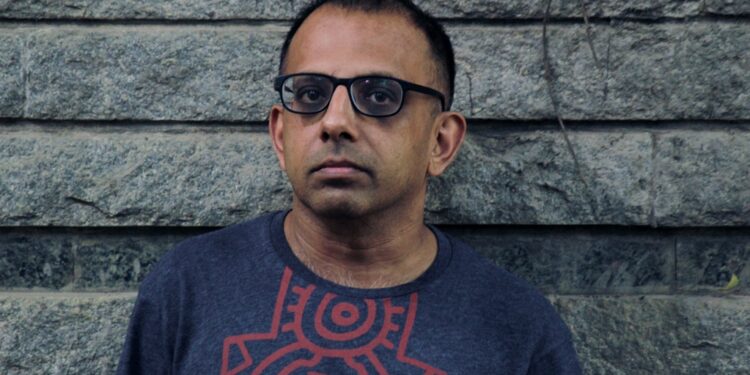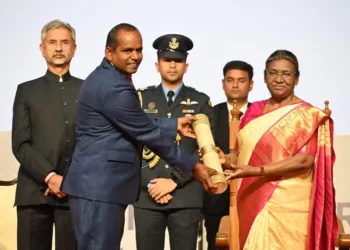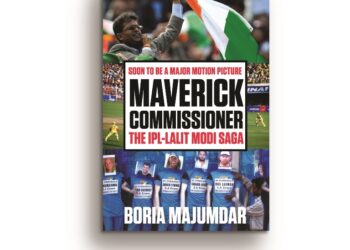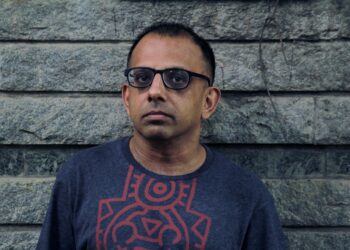Translating can be a tricky business. In the hands of experts, translated texts can be as riveting as the author intended. Putting this skill in the forefront recently was Geetanjali Shree’s International Booker prize where the £50,000 was split between the author and the translator equally. We talk to renowned translator ARUNAVA SINHA, winner of multiple awards and co-director, Ashoka Centre of Translation, to understand this evolving space better
BY RUKMA SALUJA
There’s a buzz around Tomb of Sand where the translator took centre stage along with the author. Is this the way forward or is it a flash in the pan?
In India translators have often been put on the cover, so that’s not a problem. The reason that the translator took centre stage in this case is because this is an award meant specifically for translators and authors, unlike the JCB Prize which is for the book. This is for the translators as
well. But we must always remember that we are reading something by the author, so not too much attention can be shifted to the translator, then it distracts attention from the author.
What do you have to take care of when translating?
Everything—the meaning in the most basic sense, the implied meaning, sound, music, tone, voice, intention, effect, context. That your readership is culturally different from the work decides how far you need to go in bridging that cultural gap. Translation is a constant process of
making choices as you make the journey from one language to another.
How do you take care of the cultural differences of readers? How much does one explain nuances?
Various translators have various strategies for this. I don’t use glossaries or footnotes. By putting in stealth glosses, we sneak in very short explanations, where what is being talked about might be completely unintelligible to a readership from a different space and time, but we sneak it in in a way that suggests it is a part of the text itself and not a separate note. Very often we don’t explain everything because
a reader can also make the effort if they have to. Also, not everything is crucial to the story, so if there is something you can read without getting the exact meaning as it comes from a different culture yet it doesn’t affect your experience of reading the book, then I don’t go into lengthy explanations.
Food, for example. If it’s something very Bengali, I don’t explain it because it’ll sound like a menu in a restaurant; that’s not how you write when you are writing a book. And eventually it doesn’t really matter to the reader how specific the food item is. Even if many English words are
used to describe it, it won’t make much difference because the reader may not have eaten it. That’s not an experience you’re going to summon for the reader. You want the reading to continue smoothly and so it should flow naturally.
How do you deal with specific cultural references?
Some things have a wealth of meaning for locals. But you are not a local; you don’t try to be a local when you travel; you don’t want to feel what a local feels about certain things. You want to feel as you feel from the knowledge and curiosity you have. It’s exactly the same thing when
you’re reading a translated book. Do you want things to change to make them more understandable to you? Or do you want them to be as they are? In a translated work, you know the reader will come to you; you don’t have to go to the reader. They are interested in reading a translated
work in the first place and they will travel to the extent necessary. The English reader will not have the same experience as the Bengali, Hindi, Tamil reader, because the relationships with the language are very different. One works within that space.
Why have our translations suffered? International translations are released simultaneously.
Because certain writers like, say, Dan Brown or Haruki Murakami are already global names. That global audience is keen to read their works as quickly as possible. The publishers take that position. It’s a journey; it doesn’t happen overnight. Remember that translation in India at a serious level, on an industrial scale, as it were, is barely 15 years old. It will take time and happen when our authors become household names.
If you were to ask a Marathi reader about a Malayalee author they probably wouldn’t be able to name one. Our writers from regional languages are not nationally known. They are getting there; their books are getting translated. Today Geetanjali Shree’s name is known to all readers in
India no matter which language they read in. When we have more writers like that their books will be translated quickly, although not sure about simultaneously.
Even the global phenomenon didn’t happen overnight. It took a hundred years for Russian and French classical writers like Zola and Dostoevsky, and another 100 before you had a Dan Brown and a Murakami being translated simultaneously in six languages.
Is there a danger of ‘over’ translation?
Most definitely, when you feel you’ve understood the text and you start using extra words to convey the meaning. Like mansplain—it’s translatorsplain; when you as the translator feel you’ve understood the text so well you must explain it, open it up and not leave the reader in any doubt. That’s not how you want to read good content—like a teacher explaining to students. Translations are read for nuance, ambiguities, as texts that have many possibilities for interpretation. The translator’s job is to leave all the potential and possibilities intact in the text and not reduce them to any one thing.
How do you capture mood and nuance?
It’s difficult. If it were easy, there would be many more translators. It’s difficult because you have to read very sensitively; you have to put yourself as a writer out of the equation altogether; you have to remember you are not writing this book, someone else has written it already. It’s not easy but as you do more, you get better at it; and it doesn’t seem so impossible.
How do you keep the author’s style?
That’s exactly what you’re there for, that’s your job. It doesn’t matter if it’s easy or difficult; it has to be done. You can’t put yourself in there.
What’s more difficult—fiction or nonfiction?
It’s not a matter of genre; it’s a matter of the text. If a text throws up challenges, then the job at hand is tough.
What was the most challenging?
Every work has its own challenges but perhaps the two that come to mind were Bankim Chandra Chattopadhyay’s The Chieftain’s Daughter (Durgesh Nandini). It was written in highly ‘Sanskritised’ Bangla and was a challenge to understand in terms of meaning and then to maintain
that elevated tone and the grandeur of it all without it becoming incomprehensible. Khwabnama by Bangladeshi author Akhteruzzaman Elias. It is a fantastic work of literature. I was constantly worrying if I was going to do justice to it.
Do you have a particular process? Do you read the entire text first?
Sometimes, I don’t read it even once; I read it as I go along. I don’t think I’ve ever read a book several times before translating it. That can be quite detrimental actually. It takes away from the freshness of the language; the text becomes dead to you and that becomes dangerous to you as a translator.
Arunava translates classic, modern and contemporary Bengali fiction and nonfiction into English. Seventy-one of his translations have been
published so far. Twice the winner of the Crossword translation award, for Sankar’s Chowringhee (2007) and Anita Agnihotri’s Seventeen (2011), and the winner of the Muse India translation award (2013) for Buddhadeva Bose’s When The Time Is Right, he has also been shortlisted for The
Independent Foreign Fiction prize (2009) for his translation of Chowringhee and for the Global Literature in Libraries Initiative Translated YA Book Prize for his translation of Md Zafar Iqbal’s Rasha, and longlisted for the Best Translated Book award, USA, 2018 for his translation of Bhaskar Chakravarti’s Things That Happen and Other Poems. In 2021, his translation of Taslima Nasrin’s Shameless was shortlisted for the National Translation Award in the USA. Besides India, his translations have been published in the UK and the US in English, and in several European and Asian countries through further translation. He is an associate professor of practice in the Creative Writing department at Ashoka University, and co-director, Ashoka Centre of Translation.








